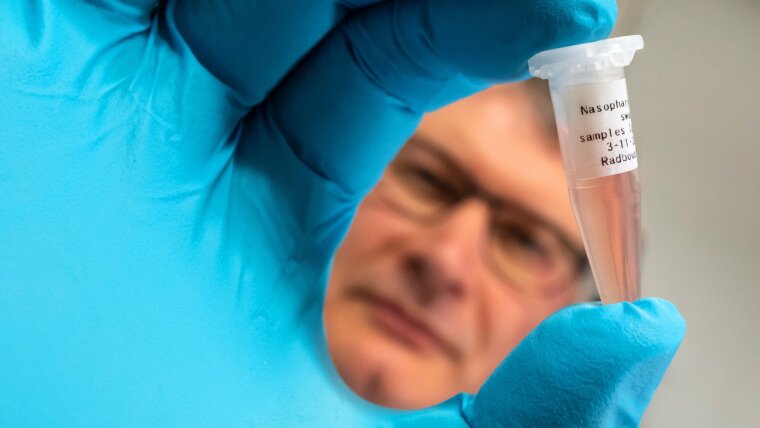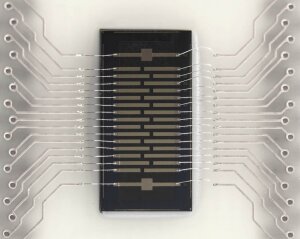
- Light
Published: | By: Sebastian Hollstein
Source article
A graphene biosensor chip on a printed circuit board, connected by wirebond wires. With this setup, highly sensitive biomeasurements can be performed directly in complex clinical samples without the need for amplification or label coupling.
Image: Jens Meyer (University of Jena)Two-dimensional materials such as graphene are not only ultrathin, but also extremely sensitive. Researchers have therefore been trying for years to develop highly sensitive biosensors that utilise this property. Graphene-based field-effect transistors, for example, could register the tiniest changes in the electronic properties caused by the molecules when they interact with this atomically thin layer. However, the hypersensitivity of the material has so far stood in the way of the practical realisation of this idea. Scientists at Friedrich Schiller University Jena have now developed a solution to overcome this obstacle, potentially paving the way for a revolution in diagnostics. They have published their findings in the research journal "Advanced Materials".
Just like other biosensors, a graphene-based biosensor requires a functionalised surface on which only specific molecules can attach. If, for example, a specific biomarker is to be detected from a blood or saliva sample, a corresponding counterpart - a so-called capture molecule - must be applied to the sensor surface. The problem: "If graphene is functionalised directly, its electronic structure changes unfavourably," explains Prof. Dr Andrey Turchanin from the University of Jena. "Graphene is then no longer graphene - the specific electronic properties that you actually want to utilise are then no longer available." Parameters that make up the high sensitivity of such a biosensor - for example the mobility of the charge carriers - are too strongly influenced.
Functionalisation thanks to a molecular intermediate layer
However, Turchanin and his team, together with partners from industry, research and medicine, have now developed a method to functionalise graphene without interference. "We have applied a molecular carbon membrane to the graphene, which is just as thin as graphene at one nanometre. This intermediate layer is dielectric, which means that it does not conduct electricity," explains the Jena chemist. "Both components are connected to each other by so-called van der Waals forces and form a heterostructure that we were able to functionalise without affecting the electronic properties of the graphene." This is because chemically active functional groups can be applied to the molecular intermediate layer without interference, to which any number of different capture molecules can be attached. When the desired counterparts attach, they transmit the electric field to the graphene, which changes the electrical signals in this material without affecting its properties.
Investigation of complex clinical samples
As capture molecules, the researchers equipped the chemically active functional group on the molecular intermediate layer with artificially produced aptamers that can bind specific molecules in a very targeted manner. They also functionalised the carbon nanomembrane with a protein-repellent layer of polyethylene glycol, a synthetic polymer that is often used in medicine. It prevents something from adsorbing on the surface that is not wanted. In this way, the biomarkers sought can be found in a complex biological sample.
With this experimental set-up, the experts in Jena succeeded in detecting chemokines - a certain group of proteins that play an important role in the human immune system and can therefore play a major role as biomarkers in the diagnosis of illnesses. "Thanks to the cooperation with a medicine laboratory in the Netherlands, we used samples from nasal swabs of real patients for these experiments," says Andrey Turchanin. "What's more, the graphene sensors we developed can be used to find not just one biomarker, but hundreds," adds Dr David Kaiser, the first author of the publication.
More sensitive, faster, cheaper
"This research result could be groundbreaking for the diagnostics of the future, because we have been able to remove a major hurdle on the way to a graphene-based biosensor that is far more effective than anything currently used in normal clinical applications area," says Kaiser. "It is much more sensitive, significantly faster - the results are available in around five minutes - and cost-effective if it is produced in large quantities." The measuring principle is purely electrical - changes in the electrical current alone indicate whether the biomarkers being sought have been found. Accordingly, such a biosensor can be easily integrated into everyday clinical practice in conjunction with a handy point-of-care device. "It's probably even possible with our mobile phones," says Turchanin.
Original publication:
D. Kaiser et al: "Ultrasensitive Detection of Chemokines in Clinical Samples with Graphene-Based Field-Effect Transistors", Advanced Materials, 2024; DOI: 10.1002/adma.202407487External link
